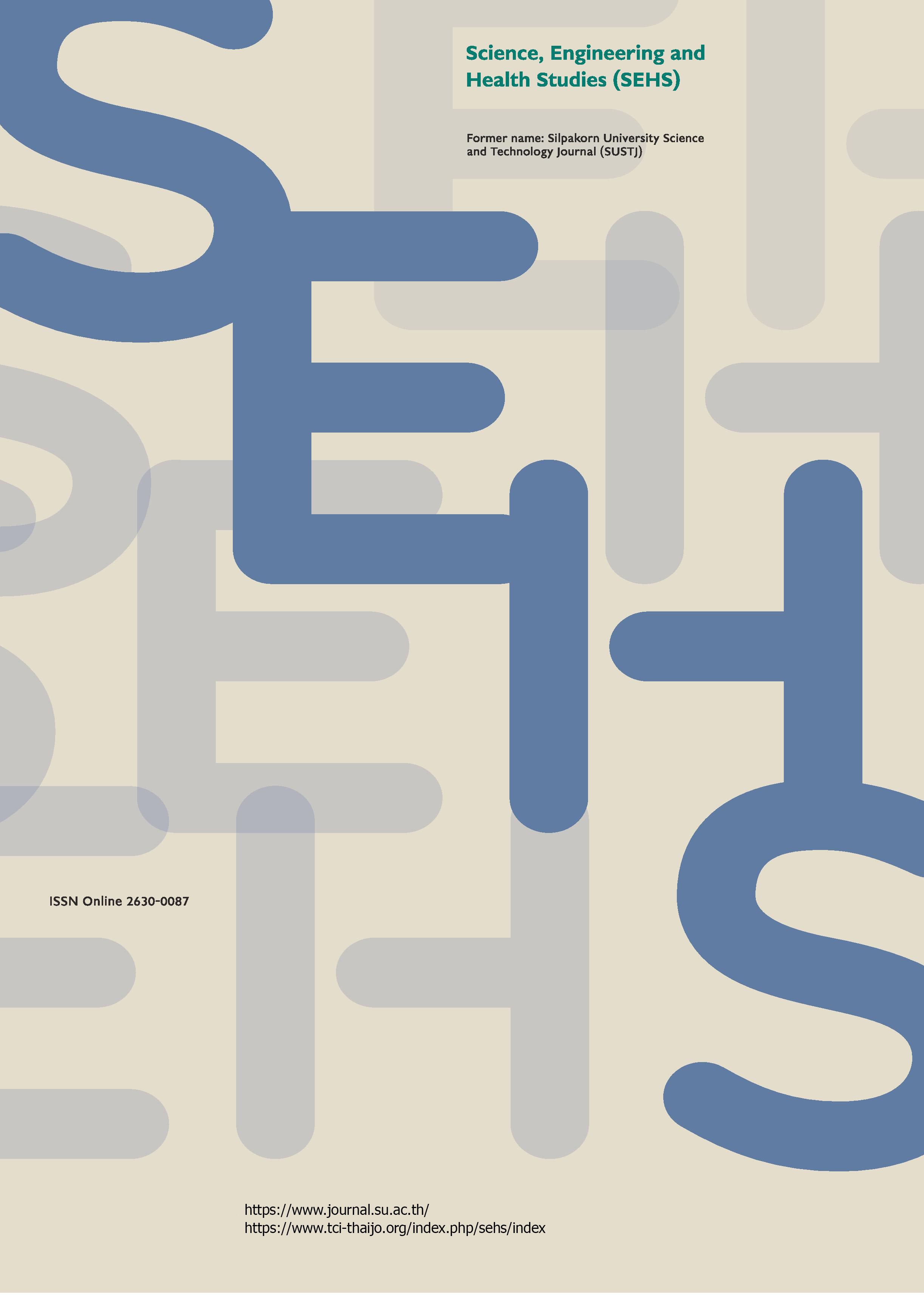Walking pattern analysis using the gait cycle to classify a healthy and an unhealthy form
Main Article Content
Abstract
This study proposed an algorithm to classify normal and abnormal forms of walking patterns by identifying the swing and stance phases, known as the gait cycle. The walking patterns were examined by collecting data using Razor IMU sensors. The Wi-Fi transmitter was utilized to transfer raw data for further analysis, representing the gait cycle using a linear graph. The data were preprocessed and transformed into phase graphs using the polar coordinate equation. To identify areas of density, data were incorporated into K-mean clustering. A k-value of 2 groups represented the major walking phases and classified patterns based on a regional model. The experimental results enable us to define healthy and unhealthy forms. This algorithm conveniently assists in diagnosing basic physical conditions, and the dataset is efficient for monitoring the medical treatment process among recipients.
Downloads
Article Details

This work is licensed under a Creative Commons Attribution-NonCommercial-NoDerivatives 4.0 International License.
References
Anwary, A. R., Yu, H., and Vassallo, M. (2018). Optimal foot location for placing wearable IMU sensors and automatic feature extraction for gait analysis. IEEE Sensors Journal, 18(6), 2555–2567.
Boyer, C. B. (1949). Newton as an originator of polar coordinates. American Mathematical Monthly, 56(2), 73–78.
Campellone, J. V., Dugdale, D. C., and Conaway, B. (2023). Walking abnormalities. Mount Sinai. [Online URL: https://www.mountsinai.org/health-library/symptoms/walking-abnormalities] accessed on October 19, 2023.
Chattopadhyay, S., and Nandy, A. (2018). Human gait modeling using hidden Markov model for abnormality detection. In TENCON 2018 – 2018 IEEE Region 10 Conference, Jeju, Korea (South). October 28-31.
Cormen, H. T., Leiserson, C. E., and Rivest R. L., and Stein, C., (2004). Introduction to Algorithms, 3rd, Cambridge: The MIT Press, pp. 915–918.
Hartigan, J. A., and Wong, M. A. (1979). Algorithm AS 136: A k-means clustering algorithm. Journal of the Royal Statistical Society. Series C (Applied Statistics), 28(1), 100–108.
Inman, V. T., Ralston, H. J., and Todd, F. (1981). Human Walking, Baltimore: Williams and Wilkins, pp. 154-156.
Johnson, S. G., and Frigo, M. (2007). A modified split-radix FFT with fewer arithmetic operations. IEEE Transactions on Signal Processing, 55(1), 111–119.
Kongkhiaw, C. (2010). Video system for dynamic motion analysis of human gait. Master’s thesis. Prince of Songkhla University, Thailand.
Microtronic. (2017). Roll, Pitch, Yaw. [Online URL: https://4.bp.blogspot.com/-ke68uluPCc/WPyIpowu9jI/AAAAAAAADuE/EqAOFzyqYKAr6QtI1A7T8z7dOFFipyc9wCLcB/s640/advanced-aerodynamics-4-728.jpg] accessed on October 19, 2023. [in Thai]
Pelleg, D., and Moore, A. (1999). Accelerating exact k-means algorithms with geometric reasoning. In Proceedings of the Fifth ACM SIGKDD International Conference on Knowledge Discovery and Data Mining, pp. 277–281. California, USA.
Rodgers, M. M. (1995). Dynamic foot biomechanics. Journal of Orthopaedic and Sports Physical Therapy, 21(6), 306–316.
Romtrairat, P., Virulsri, C., Wattanasiri, P., and Tangpornprasert, P. (2020). A performance study of a wearable balance assistance device consisting of scissored-pair control moment gyroscopes and a two-axis inclination sensor. Journal of Biomechanics, 109, 109957.
Santikan, P., Tangwongcharoen, W., and Kimpan, W. (2022). Define stance and swing pattern of gait cycle using motion sensor and k-mean clustering. In Proceeding of the 19th International Conference on Electrical Engineering/Electronics Computer, Telecommunications and Information Technology (ECTI-CON), pp. 1–4. Prachuap Khiri Khan, Thailand.
Seyrafi, A. (2009). Real time automatic step detection in the three dimensional accelerometer signal implemented on a microcontroller system. Master’s thesis. Blekinge Institute of Technology, Sweden.
Soangra, R., Wen, Y., Yang, H., and Grant-Beuttler, M. (2022). Classifying toe walking gait patterns among children diagnosed with idiopathic toe walking using wearable sensors and machine learning algorithms. IEEE Access, 10, 77054–77067.
Tadano, S., Takeda, R., and Miyagawa, H. (2013). Three dimensional gait analysis using wearable acceleration and gyro sensors based on quaternion calculations. Sensors, 13(7), 9321–9343.
Tadano, S., Takeda, R., Sasaki, K., Fujisawa, T., and Tohyama, H. (2016). Gait characterization for osteoarthritis patients using wearable gait sensors (H-Gait systems). Journal of Biomechanics, 49(5), 684–690.
Victory State Government. (2022). Walking for good health. Better Health Channel. [Online URL: https://www.betterhealth.vic.gov.au/health/healthyliving/walking-for-good-health] accessed on October 19, 2023.
Yakimovich, T., Kofman, J., and Lemaire, E. D. (2006). Design and evaluation of a stance-control knee-ankle-foot orthosis knee joint. IEEE Transactions on Neural Systems and Rehabilitation Engineering, 14(3), 361–369.
Yuan, Q., and Chen, I.-M. (2014). Localization and velocity tracking of human via 3 IMU sensors. Sensors and Actuators A: Physical, 212, 25–33.


